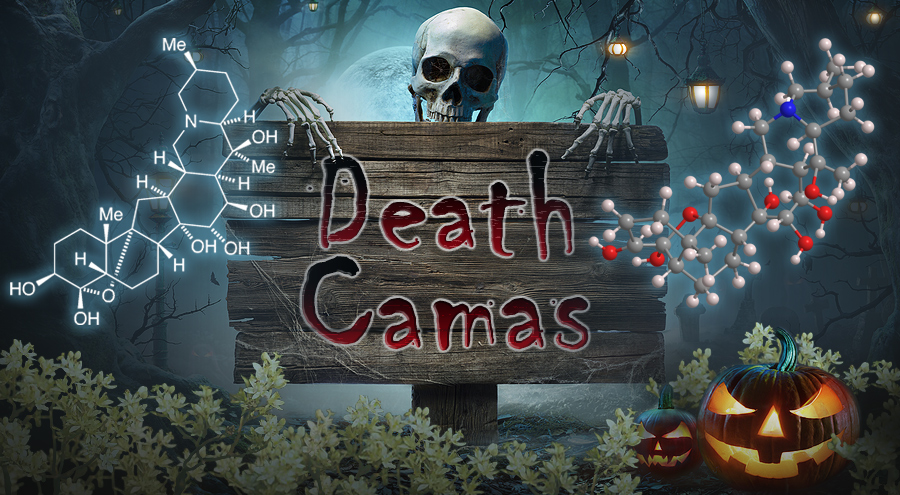What molecule am I?

Zygadenine is an alkaloid and a principal component of several flowering plants in the family Melanthiaceae. In common terminology, many of these plants are called “death camas”. Some species in this family, all found in North America, are Toxicoscordion venenosum (meadow death camas), Anticlea elegans (mountain death camas), and Zigadenus glaberrimus (sandbog death camas), from which zygadenine gets its name. Zygacine1, the 3-acetyl ester of zygadenine is another principal component of death camas.
In 1913, F. W. Heyl*, F. E. Hefner, and S. K. Loy at the University of Wyoming (Laramie) identified an alkaloid in Zygadenus intermedius2 that they called zygadenine. They assigned it an empirical formula of C39H68NO10, which is impossible for a neutral molecule. Not until 36 years later did Heyl, now at Upjohn (Kalamazoo, MI), and colleague M. E. Herr correct the formula to C27H43NO7.
In a brief 1956 communication, S. Morris Kupchan at the University of Wisconsin (Madison) reported the structure of zygadenine. In a full article in 1959, Kupchan verified the structure and explored several zygadenine derivatives.
Why has so much attention been given to zygadenine and zygacine? Originally, of course, it was because they are such deadly poisons. Even today, there is no antidote; atropine or dopamine is usually administered to treat symptoms such as bradycardia (slow heart rate) and hypotension (low blood pressure).
Like many natural toxins, zygadenine and its derivatives have been evaluated for medical uses. A 2019 Chinese patent states that zygadenine showed some improvement against histamine-induced vascular permeability increase and allergen-induced anaphylactic shock. And last year, Baoquan Bao, Ping Zhang, and co-workers at Inner Mongolia Medical University (Hohhot, China) included zygacine in a screening of traditional Mongolian medicines to determine whether any might show activity against COVID-19. Their conclusion: All 20 compounds they studied are worthy of further study as antivirals.
Although zygadenine and zygacine are highly toxic, no regulation-based hazard information is available.
1. CAS Reg. No. 2777-79-9.
2. The original name of Toxicoscordion venenosum.
Zygadenine fast facts
| CAS Reg. No. | 545-45-9 |
| SciFinder nomenclature | Cevane-3,4,14,15,16,20-hexol, 4,9-epoxy-, (3β,4α,15α,16β)- |
| Empirical formula | C27H43NO7 |
| Molar mass | 493.63 g/mol |
| Appearance | White crystals |
| Melting point | 218–220° C |
| Water solubility | Not reported, probably insoluble |
MOTW update
Cadmium selenide (CdSe) was the Molecule of the Week for October 9, 2017. It is an n-type semiconductor, which makes it ideal for nanotech applications, including use as an ingredient in quantum-dot light-emitting diodes.
This July, Shunai Che and collaborators at Shanghai Jiao Tong University, Tongji University, and East China Normal University (all in Shanghai) reported that CdSe and its cousin cadmium sulfide (CdS) can combine to form chiral helical CdSe@CdS nanorods. Remarkably, in the presence of only achiral molecules, CdSe and CdS self-assemble spontaneously to form the chiral rods. This is an example of spontaneous chiral symmetry breaking, a crucial phenomenon in the origin of homochirality in nature.

Learn more about this molecule from CAS, the most authoritative and comprehensive source for chemical information.
Molecule of the Week needs your suggestions!
If your favorite molecule is not in our archive, please send us a message. The molecule can be notable for its current or historical importance or for any quirky reason. Thank you!
Stay Ahead of the Chemistry Curve
Learn how ACS can help you stay ahead in the world of chemistry.

